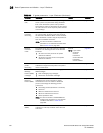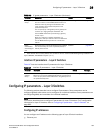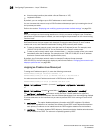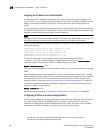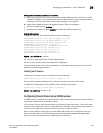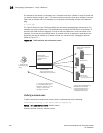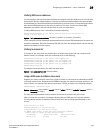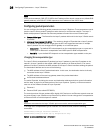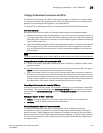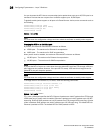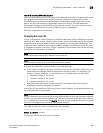
802 PowerConnect B-Series FCX Configuration Guide
53-1002266-01
Configuring IP parameters – Layer 3 Switches
26
Assigning an IP address to a virtual interface
A virtual interface is a logical port associated with a Layer 3 Virtual LAN (VLAN) configured on a
Layer 3 Switch. You can configure routing parameters on the virtual interface to enable the Layer 3
Switch to route protocol traffic from one Layer 3 VLAN to the other, without using an external
router.
1
You can configure IP routing interface parameters on a virtual interface. This section describes how
to configure an IP address on a virtual interface. Other sections in this chapter that describe how to
configure interface parameters also apply to virtual interfaces.
NOTE
The Layer 3 Switch uses the lowest MAC address on the device (the MAC address of port 1 or 1/1)
as the MAC address for all ports within all virtual interfaces you configure on the device.
To add a virtual interface to a VLAN and configure an IP address on the interface, enter commands
such as the following.
PowerConnect(config)# vlan 2 name IP-Subnet_1.1.2.0/24
PowerConnect(config-vlan-2)# untag ethernet 1 to 4
PowerConnect(config-vlan-2)# router-interface ve1
PowerConnect(config-vlan-2)# interface ve1
PowerConnect(config-vif-1)# ip address 1.1.2.1/24
The first two commands in this example create a Layer 3 protocol-based VLAN name
“IP-Subnet_1.1.2.0/24” and add a range of untagged ports to the VLAN. The router-interface
command creates virtual interface 1 as the routing interface for the VLAN.
Syntax: router-interface ve <num>
The <num> variable specifies the virtual interface number. You can enter a number from 1 through
4095.
When configuring virtual routing interfaces on a device, you can specify a number from 1 through
4095. However, the total number of virtual routing interfaces that are configured must not exceed
the system-max limit of 512. For more information on the number of virtual routing interfaces
supported, refer to “Allocating memory for more VLANs or virtual routing interfaces” on page 476.
The last two commands change to the interface configuration level for the virtual interface and
assign an IP address to the interface.
Syntax: interface ve <num>
Refer to the syntax description in “Assigning an IP address to an Ethernet port” on page 800.
Configuring IP follow on a virtual routing interface
IP Follow allows multiple virtual routing interfaces to share the same IP address. With this feature,
one virtual routing interface is configured with an IP address, while the other virtual routing
interfaces are configured to use that IP address, thus, they “follow” the virtual routing interface
that has the IP address. This feature is helpful in conserving IP address space.
1. The Dell feature that allows routing between VLANs within the same device, without the need for
external routers, is called Integrated Switch Routing (ISR).



